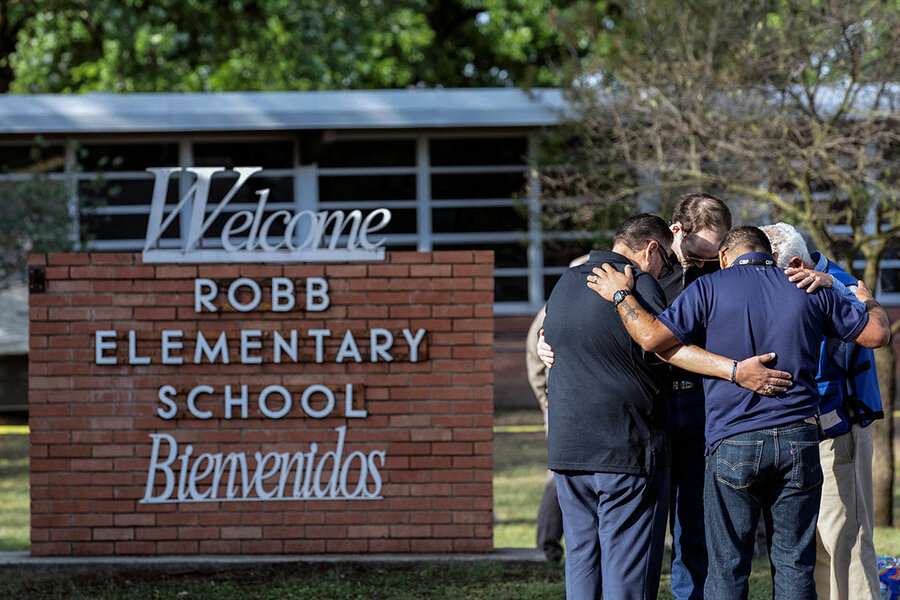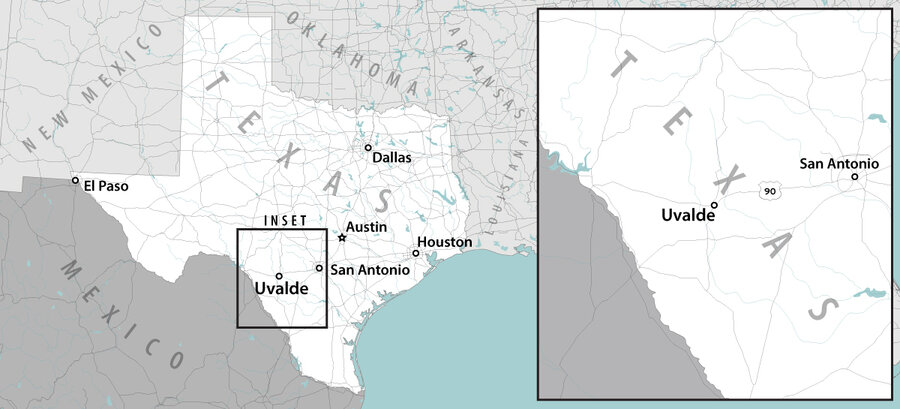Sleepless night: Uvalde seeks courage in a school shooting’s wake
Loading...
| Uvalde, Texas
Two dogs play at Kassy Salazar’s feet as she stands in her backyard, absorbing the loss of her cousin, a teacher at the Robb Elementary School. Trying to sleep, Ms. Salazar had hoped to wake up and learn it had all been a dream. Now she’s waiting for her parents, and for her cousin’s family to get here from the nearby town of Eagle Pass.
Uvalde “is not going to be the same ever again,” she says.
Why We Wrote This
In Uvalde, familiar questions echo, as they had in Santa Fe, in El Paso, and in Sutherland Springs. How could something like this happen here, in this town? In our town?
Nineteen children and two adults were killed Tuesday by a teenager, two days before school got out for the summer. It was the deadliest attack on an elementary school since the Sandy Hook shooting in Newtown, Connecticut, in 2012.
Felix Rubio spent the morning wandering the streets. One of his nephews had survived the shooting, but one of his nieces hadn’t. He spent the evening before shooing reporters away from his in-laws’ home.
“I feel lost,” he says. “I don’t know what to feel. I feel mad. I feel sad. I feel helpless.”
Whatever happens now, the town will face it together.
Ms. Salazar tried living in San Antonio for a while, but she came back. She’s not about to leave again.
“Family, friends, being together ... being here” gives her hope, she adds. “Our community is strong. We’ll get through this.”
Uvalde rose to a beautiful spring morning today – but most here had barely slept.
Kassy Salazar had tried to get some sleep, even after learning that her cousin, Eva Mireles, had been one of the teachers murdered at Robb Elementary School. The constant sirens outside her window kept her up.
Felix Rubio lay in his bed early in the morning, asking himself: Why? Why? Why? When he finally got up, he spent the morning wandering the streets here. One of his nephews had survived the shooting, but one of his nieces hadn’t. He spent the evening before shooing reporters away from his in-laws’ home.
Why We Wrote This
In Uvalde, familiar questions echo, as they had in Santa Fe, in El Paso, and in Sutherland Springs. How could something like this happen here, in this town? In our town?
“I feel lost,” he says. “I don’t know what to feel. I feel mad. I feel sad. I feel helpless.”
Nineteen children and two adults were killed Tuesday by a teenager, two days before school got out for the summer. It was the deadliest attack on an elementary school since the Sandy Hook shooting in Newtown, Connecticut, in 2012. Law enforcement officers and an off-duty Border Patrol officer engaged with the shooter after he crashed his car and ran into the school wearing body armor. He was ultimately killed.
“There’s no words that anybody can come up here and do anything to heal those broken hearts,” Texas Gov. Greg Abbott said Wednesday at a press conference. “Every Texan, every American, has a responsibility where we need to focus not on ourselves and our agenda, but the healing and hope we can provide to those who have suffered unconscionable damage to their lives – and loss of life.”
The morning was cool and quiet, as Uvalde seemed to sit in numb disbelief. Many stores that closed yesterday afternoon, as news of the shooting filtered through the town, stayed closed. Familiar questions echoed as they had in Santa Fe, in El Paso, and in Sutherland Springs. How could something like this happen here, in this town? In our town?
Why here, but also, why there? Ms. Salazar had been a student at Robb Elementary in third and fourth grade. She barely remembers it. So had Adolfo Hernandez, who went to the press conference held by Governor Abbott, so he could “protest the government.” After shouting at the governor from the back of the high school auditorium, he was escorted from the room.
“I’m heartbroken,” he said afterward, in the high school parking lot. “I feel terrible, and when my own government locks me out as well, it hurts even more.”
By this point, the sun has burned away the cool morning air. There is a sense that disbelief is turning to anger. Uvalde cycles, like the communities before it, through the stages of grief. As of this afternoon, even law enforcement seemed stunned.
“We have yet to find a clue that might have given us any type of idea that he was about to do something like this,” said Col. Steve McGraw, director of the Texas Department of Public Safety, at the press conference.
“We have scoured everything we could find, what could have indicated that this individual was a threat to the community, and we have found none at all,” he added. “We’re astounded because there’s usually something out there.”
This is a small town in South Texas, and provides all the trappings of a small Texas town. There’s a main street, with a big feed store and a grocery store, an H-E-B. There’s a Dairy Queen and a handful of taquerias. The high school is the home of the Fighting Coyotes and Lobos, and English and Spanish cohabit peacefully – though it wasn’t always this way.
Ramiro Gamez has lived here for three decades. He woke up this morning afraid for his grandchildren, he says in Spanish. His hands are shaking.
“I’m going to keep a close eye on [them] now,” he adds.
Two dogs play at Ms. Salazar’s feet as she stands in her backyard. Trying to sleep, she had hoped to wake up and learn it had all been a dream. Now she’s waiting for her parents, and for her cousin’s family to get here from the nearby town of Eagle Pass, where her cousin is from.
Uvalde “is not going to be the same ever again,” she says.
But whatever happens now, the town will face it together.
Ms. Salazar tried living in a big city once. She lived in San Antonio for a while, but she came back here. She’s not about to leave again.
“Family, friends, being together ... being here” gives her hope, she adds. “Our community is strong. We’ll get through this.”
Staff writer Patrik Jonsson contributed to this report.











